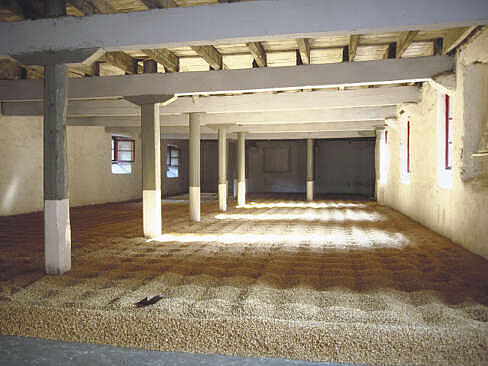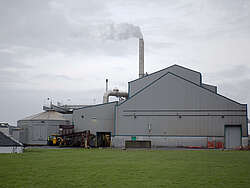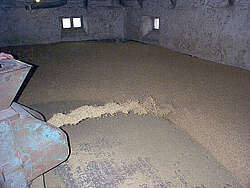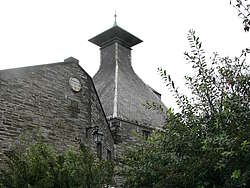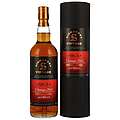Malt production is the starting point of malt whisky production! Barley malt is used as the starting product for single malt whisky production. This article deals with the production method of malt and the necessary technical equipment and rooms. If you are not yet familiar with the basic production method for single malt whisky, you can find out more in this video and article.
As the name suggests, barley malt is made from barley. However, the harvested barley grain cannot be processed directly into beer or whisky. The starch stored in the barley grain must first be broken down into sugar before the yeasts can begin fermentation. You can find out exactly how this happens chemically in our article From grain to alcohol.
In the past and today
Although the production of barley malt always follows the same basic process of soaking, germination and drying, two different production methods have emerged in the past: Malt Floor and Saladin Box. Today, the majority of malt for whisky production is produced in so-called drum maltings exactly according to the specifications of the distilleries. What you are reading here is a look back into the past.
Photos of various maltings are shown below to illustrate this. Until 2010, only Tamdhu still had the Saladin boxes, in which you can produce a lot of malt in one batch due to the malt layer being over a metre thick. Tamdhu used its Saladin boxes to produce malt for Macallan, Glenrothes and other distilleries in the group. All other small maltings still in operation work with simple malting floors and have only a low malt output. Whenever you see photos of Tamdhu here, please be aware that it was a large-scale malting plant.
Over a hundred years ago, there were only malting floors on which the distilleries - just like the breweries - germinated their barley into barley malt. The first step towards automation was Saladin boxes, which automated the germination of the barley, but did not offer any advantages when drying the malt. Today, drum dryers are used on a large scale for drying, but we will not go into these in detail in this article.
Only a few distilleries still have their own small malting plants. Admired by many and regarded as particularly authentic, the malt from these maltings costs the distilleries far more than the industrially produced malt from specialised large-scale maltings (e.g. Port Ellen).
The chemical process
In the production of malted barley, the barley grain is given the illusion of an ideal, warm and moist environment for germination. What has to happen, happens. The barley grain activates the solar energy stored in the field and converts the built-up starch into sugar. Sugar that the 'small factory' barley grain would like to convert into cellulose in order to grow roots and a sprout with leaves.
However, after breaking down starch into sugar, humans interrupt this process by drying it and use the malt sugar (maltose) to produce a sweet, watery liquid (wort). To do this, the malt is first coarsely ground. The sugar is then dissolved with hot water and finally fermented with yeast to produce beer, which is then distilled.
Anlieferung der Gerste
Today, the barley is transported to the distillery by lorry. 40-tonne lorries, fully loaded with dried barley, drive to the distilleries. It makes no difference if a distillery no longer has its own malting plant. In this case, the lorry delivers the finished malt straight away. But here we are looking at the rare case of the distillery having its own malting plant. There are fewer than 10 of these distilleries left: Balvenie, Bowmore, Glen Garioch, Glen Ord, Highland Park, Laphroaig, Speyburn and Springbank. Apart from Speyburn and Glen Ord with pneumatic drum maltsters, the other distilleries only produce some of their malt on their own malting floors, mainly for their reputation with visitors.
Before 30 cubic metres of barley are taken into the malting plant's silos, the distillery must take a sample and check the quality of the barley. Only if the barley fulfils certain quality criteria such as density, moisture, starch content, germination capacity, nitrogen content and purity does the inspector allow the barley to be accepted. The quantity of ripening fungi and pests is also checked. To take the sample from the lorry, the inspector uses a special sampling arm, the so-called monkey.
Das Einweichen
Anyone who has ever bitten into a raw grain knows how hard these dried grains are. Before germination , these grains must therefore be soaked for several days. During this time, they soak up all the water they need to trigger the biological germination process. The soaking process takes around two to three days. It goes without saying that the same pure spring water is used for this as for dissolving the sugar.
Traditionelle Mälzerei
With the help of simple tools such as wheelbarrows and rakes, the soaked barley is spread out on the malting floors to a height of around 8 to 12 cm.
The malting floors must be properly ventilated to prevent fungi or bacteria from attacking the barley. But that's not all. The barley must be turned regularly, as the biological reaction heats the barley in the middle layer. To ensure that all the barley is finished evenly, the maltster makes sure that the barley is not overheated and that it is turned and completely mixed. Despite all this, the result remains 'sub-optimal'. Even the best maltster has to bow to the results of modern large-scale malting plants in this respect.
Speaking of bending: In the past, a large part of the turning work was carried out with the malt shovel. After 30 years of turning malt with the shovel, the workers tended to suffer permanent deformities to their skeletons. This occupational disease was aptly named 'monkey shoulder'.
A rake driven by electric motors ran regularly along the side rails through the barley layer, which was more than a metre high. The grains were evenly mixed by large, helically bent plates. As the temperature and humidity of the rooms were controlled by air conditioning and ventilation, the conversion rate between starch and malt sugar was much higher in these apparatuses than on the malting floor.
The Tamdhu malting plant had a whole floor full of these Saladin boxes, which were in operation around the clock. The Saladin boxes were emptied via the suction pipes visible in the foreground.
Trocknung
The subsequent drying process is carried out in the same way for large and small-scale malting. When the barley grain, which we now prefer to call malt, bursts open and begins to form its roots and germ, the germination process is stopped. This is because the development of the germ consumes the sugar from the malt, which is then no longer available for fermentation.
Sprouting is broken off by heating and drying. Heating to more than 70 degrees destroys the enzymes (amylases) released by the barley grain for germination and drying ensures that moulds and bacteria no longer attack the fresh malt.
The still moist malt is spread out on a perforated drying floor above a fireplace. This kiln is also called a kiln. These kilns were used as early as 6,000 BC and could reach temperatures of up to 900°C at that time. Kilns were used for drying ceramics, tobacco and malted barley, among other things. The drying floor, on which the barley is spread out, is placed above the hot fire source. The floor often consists of tensioned steel wires that are spaced at a smaller distance than the diameter of the malt grains. Some distilleries use peat as fuel, the smoke from which gives the malt and thus later the whisky a special, smoky flavour.
The hot exhaust air from the kiln fire is channelled through the layer of malt that has been laid out, removing the moisture that escapes into the open air via the pagoda-like chimneys. It is almost impossible to walk on a kiln floor when the fire is burning underneath. The heat of over 70 degrees, combined with extremely high humidity, immediately takes your breath away. Glasses and camera lenses fog up immediately.
After kilning, the malt can be kept for a few weeks before it is coarsely ground in the malt mill with hot water to dissolve the sugar. The mashing process is explained in detail in the following article.
Malting today
But which malt is better? The malt from your own small, time-honoured malting plant or the malt from a large malting plant? With the exception of a few journalists, the experts are unanimous. Almost without exception, the traditional, muscle-powered malting process is categorised as the less good.
Why should that be the case? Where does this judgement come from? It is extremely difficult and requires a great deal of experience to create and maintain a climate on a simple malting floor in which barley can develop and germinate optimally. As soon as the weather changes outside, the temperature or humidity is no longer in the optimum range. And in Scotland, the weather changes often. The least damage is done if the change in weather only means that germination no longer starts optimally and the process is slightly delayed. It gets worse when mould forms or bacteria and fungi multiply on the malt floor. Added to this is the introduction of dirt by mice, rats and cats.
As single malt whisky is very much linked to its traditions and must remain so, the major distilleries such as Highland Park, Bowmore and Laphroaig are not turning their backs on the ancient art of hand malting. However, the sharp rise in demand for these great malt whiskies has prompted the distilleries to switch to a three-shift, seven-day-a-week production system since the mid-1990s. Production is only interrupted for a few days a year for necessary maintenance and repairs.
However, the expansion to three-shift operation on more than 300 days a year alone shows the tradition-conscious connoisseur that malting by hand alone is no longer possible in the distilleries. The maltings' buildings were designed for normal 8-hour production and a tripling of output could not be supported by the existing malting floors. Part of the old malting floors were often converted for other purposes such as visitor centres and shops. So today we are confronted with the fact that even distilleries with their own maltings can only produce part of the malt (approx. 15% to 30%) in the traditional way - a worthy and beautiful tribute to the old tradition.
Today, barley grows in temperate latitudes in many countries. Scottish barley production has long been unable to keep up with the demand for whisky and beer, so Scotland imports some of its barley and also finished barley malt from many countries, including Germany.

